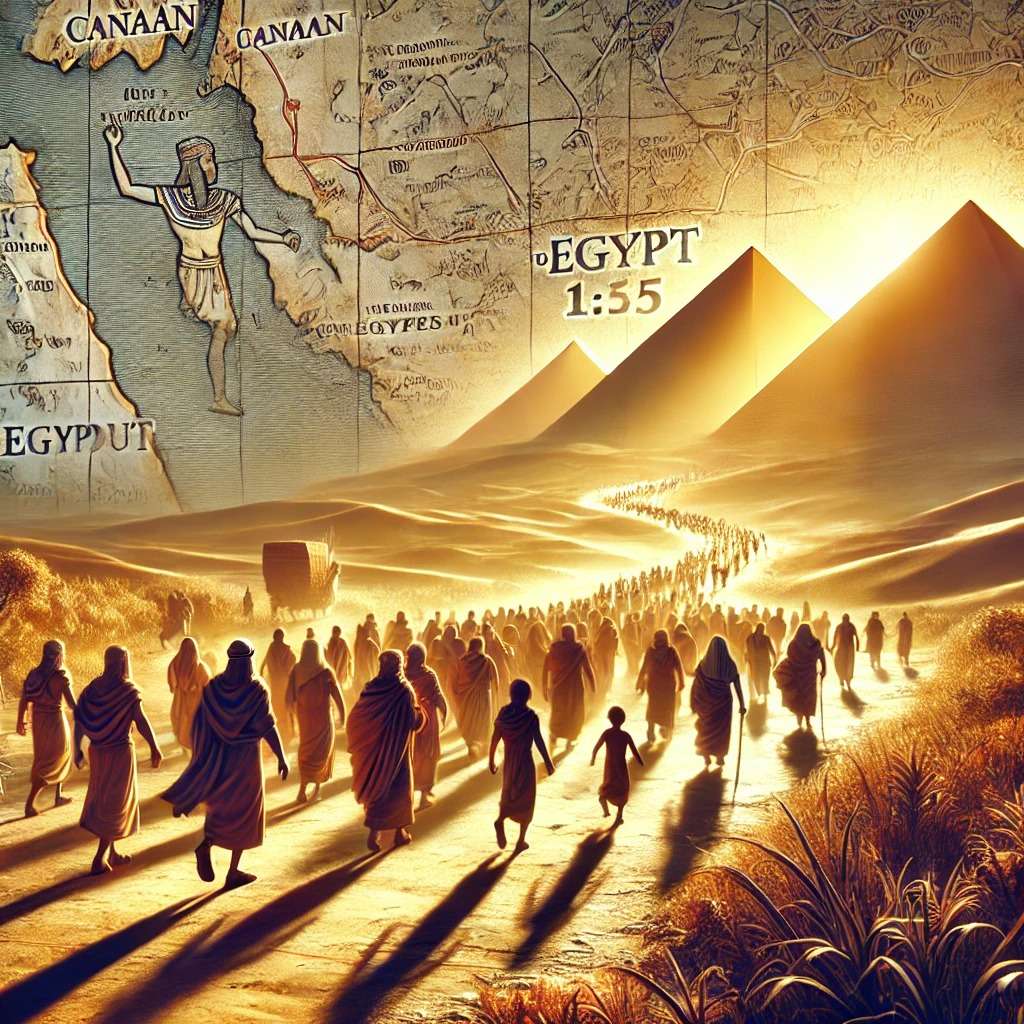
When you dive into the fascinating narrative of Exodus 1-5, you’ll uncover a pivotal moment in biblical history. This verse sets the stage for the dramatic events that follow, detailing the descendants of Jacob who journeyed to Egypt. It’s more than just a list—it’s a snapshot of a family on the brink of transformation.
Understanding Exodus 1:5 isn’t just about numbers; it’s about grasping the roots of a story that has shaped faith and culture for centuries. As you explore this verse, you’ll gain insights into how these early Israelites laid the groundwork for their incredible journey ahead. So let’s delve deeper and see what makes this passage so compelling.
Overview of Exodus 1-5
Exodus chapters 1-5 narrate critical events in the early history of the Israelites. These chapters cover their oppression in Egypt, the birth and early life of Moses, and God’s call for Moses to lead his people out of slavery.
Oppression In Egypt
Pharaoh’s fear of the growing Israelite population led to their harsh treatment. He imposed brutal labor on them and ordered the killing of all newborn Hebrew boys. This period marked significant suffering for the Israelites but also set the stage for their eventual deliverance.
Birth And Early Life Of Moses
Moses was born during this time of severe oppression. His mother hid him for three months before placing him in a basket on the Nile River. Pharaoh’s daughter found him and raised him as her own, giving Moses a unique position within Egyptian society while preserving his Hebrew identity.
God’s Call To Moses
God called Moses from within a burning bush on Mount Horeb (Sinai). He instructed Moses to return to Egypt and demand Pharaoh release the Israelites from bondage. Despite initial reluctance due to self-doubt, Moses accepted this monumental task with Aaron as his spokesperson.
Initial Confrontation With Pharaoh
Moses’ first encounters with Pharaoh were met with resistance. Pharaoh refused to free the Israelites, increasing their workload instead. These initial confrontations highlighted both Pharaoh’s stubbornness and God’s determination to liberate His chosen people through signs and wonders yet to come.
Overall, Exodus 1-5 lays foundational elements essential for understanding subsequent events leading up to one of history’s most transformative exoduses.
Plot Summary
Exodus 1-5 outlines the early struggles of the Israelites in Egypt and introduces key figures who play pivotal roles in their liberation. This section dives deeper into these events and characters.
Key Events
Several significant occurrences shape the narrative:
- Israelites’ Oppression: The Egyptians enslave the Israelites, forcing them into hard labor. Pharaoh orders all newborn Hebrew boys to be killed.
- Moses’ Birth and Rescue: Moses is born during this harsh period. His mother hides him for three months before placing him in a basket on the Nile River, where Pharaoh’s daughter finds and adopts him.
- Moses Flees to Midian: After killing an Egyptian taskmaster, Moses escapes to Midian to avoid Pharaoh’s wrath. He marries Zipporah, daughter of Jethro.
- Divine Encounter at Burning Bush: God appears to Moses through a burning bush on Mount Horeb, instructing him to return to Egypt and lead his people out of slavery.
- Initial Confrontation with Pharaoh: Moses returns to Egypt with his brother Aaron. They confront Pharaoh, demanding the release of the Israelites. Pharaoh reacts by increasing their burdens.
Major Characters
Key figures drive forward Exodus chapters 1-5:
- Pharaoh: The ruler of Egypt who enslaves the Israelites and orders infanticide.
- Moses: Central figure chosen by God to liberate His people from bondage; raised as an Egyptian prince yet aware of his Hebrew roots.
- Aaron: Moses’ older brother who assists him as a spokesperson in confronting Pharaoh.
- Jochebed (not named directly in Exodus 1): Mother of Moses who saves her son by hiding him and later placing him in a basket on the river.
These elements set up an epic tale of struggle, deliverance, and faith that continues through subsequent chapters in Exodus.
Themes And Motifs
Exodus 1-5 presents several recurring themes and motifs that are central to understanding the narrative’s depth and significance.
Oppression And Liberation
These chapters emphasize the Israelites’ severe oppression in Egypt. Pharaoh’s harsh decrees aimed to control their growing population through forced labor and infanticide. You see how this brutal treatment sets the stage for a divine rescue plan. Moses emerges as a key figure in this liberation, having been saved himself from death as an infant. The motif of liberation is highlighted through God’s call to Moses at the burning bush, signifying a turning point where deliverance becomes imminent despite the continued oppression.
Faith And Divine Intervention
Faith plays a pivotal role in Exodus 1-5. Despite their suffering, the Israelites’ faith remains steadfast, which underpins their eventual salvation. Moses’ journey reflects this theme too; his initial reluctance gives way to trust in God’s plan after witnessing divine signs. Divine intervention is apparent when God appears to Moses, promising liberation for His people and performing miracles like transforming Moses’ staff into a serpent. These instances reinforce that faith combined with divine power leads to miraculous outcomes.
Literary Analysis
Exodus 1-5 presents a rich tapestry of literary elements that enhance the narrative’s depth and impact. By examining its structure, style, symbolism, and imagery, you can gain a deeper understanding of these chapters’ thematic and theological significance.
Structure And Style
The text in Exodus 1-5 follows a linear narrative structure. It begins with the Israelites’ oppression in Egypt, transitions to Moses’ birth and his early life events, then culminates in God’s call for Moses to lead the Israelites out of bondage. This straightforward progression helps maintain clarity while advancing the plot.
The writing style blends historical reporting with dramatic storytelling. The use of direct speech (e.g., God’s conversations with Moses) adds immediacy and emotional resonance. Repetition reinforces key themes; for instance, Pharaoh’s repeated refusals highlight his obstinance against divine commands.
Symbolism And Imagery
Symbolism permeates Exodus 1-5. The Nile River symbolizes both life and death — sustaining Egyptians but posing danger to Hebrew infants (Exodus 1:22). Moses’ basket among reeds evokes protection amidst peril (Exodus 2:3).
Imagery enhances the narrative’s vividness. Descriptions of harsh labor conditions illustrate Israelite suffering under Egyptian rule (Exodus 1:13-14). Visual depictions of burning bush capture divine presence without consumption (Exodus 3:2), emphasizing God’s power over nature.
These literary devices enrich your reading experience by providing layers of meaning beyond literal interpretations.
Historical Context
Understanding the historical context of Exodus 1-5 provides deeper insights into its narrative and themes.
Cultural Background
Ancient Egypt served as the backdrop for Exodus. The Egyptians practiced polytheism, worshipping gods like Ra, Osiris, and Isis. Their society was hierarchical with Pharaoh at the top, considered a god-king. Israelites lived as laborers under harsh conditions. Their monotheistic belief in Yahweh set them apart culturally and religiously from their Egyptian oppressors.
Historical Accuracy
Scholars debate Exodus’s historical accuracy due to limited archaeological evidence. Some argue it reflects actual events while others view it as theological narrative rather than literal history. Despite this, many agree that it captures real cultural tensions between Egyptians and Israelites during ancient times, providing valuable socio-historical insights.
Theological Insights
Exodus 1-5 offers profound theological insights, illustrating the nature of God and delivering timeless lessons.
Understanding God’s Role
In Exodus 1-5, you see God’s omnipotence and compassion. He hears the cries of the Israelites (Exodus 2:23-25) and remembers His covenant with Abraham, Isaac, and Jacob. This demonstrates that God is both powerful and faithful to His promises. By sending Moses as a reluctant leader (Exodus 3:10), God emphasizes human agency within divine plans. Despite Moses’ initial hesitance (Exodus 4:10), God’s patience and assurance highlight His nurturing character.
Lessons For Modern Readers
Modern readers can draw several lessons from these chapters. Faithfulness during hardship stands out; despite severe oppression, the Israelites maintain their identity and faith in God. Another lesson is the importance of leadership grounded in humility; Moses’ story shows that true leaders often emerge from humble beginnings, guided by divine purpose rather than personal ambition. Lastly, it underscores the significance of intergenerational promises; God’s remembrance of His covenant inspires trust in long-term divine plans despite immediate struggles.
Conclusion:
Exodus 1-5
Exodus 1-5 provides a compelling narrative rich with themes of faith, deliverance, and leadership. It offers valuable lessons on navigating hardship with faith and humility while highlighting God’s unyielding compassion and omnipotence. The historical context deepens your understanding of the socio-political dynamics between Egyptians and Israelites. By reflecting on these chapters, you gain insights into the timeless relevance of intergenerational promises and the enduring power of divine intervention in times of struggle. Use this knowledge to enrich your spiritual journey and reinforce your commitment to faith during life’s challenges.
Frequently Asked Questions:
Exodus 1-5
What are the main themes discussed in Exodus 1-5?
The main themes include oppression and liberation, faith amidst divine intervention, and God’s omnipotence, compassion, and faithfulness. These chapters highlight Moses’ role in leading the Israelites to freedom from Egyptian bondage.
Who are the key characters introduced in these chapters?
Key characters include Pharaoh, who oppresses the Israelites; Moses, destined to lead them to freedom; Aaron, Moses’ brother; and Jochebed, Moses’ mother. Each character plays a vital role in the unfolding narrative of struggle and deliverance.
How does God call Moses to lead His people?
God calls Moses through a burning bush on Mount Horeb. During this encounter, God reveals His plan for Moses to deliver the Israelites from slavery in Egypt and reassures him of His support.
What is the significance of Pharaoh’s decrees?
Pharaoh’s decrees represent systemic oppression as he orders harsh labor for the Israelites and mandates that all Hebrew male infants be killed. These actions set up a backdrop of suffering that necessitates divine intervention.
What theological insights can be drawn from these chapters?
The chapters illustrate God’s omnipotence, compassion, and commitment to His promises. They emphasize that faithfulness during hardship is crucial and showcase how leadership should be rooted in humility.
How can modern readers apply lessons from Exodus 1-5?
Modern readers can draw lessons on maintaining faith during difficult times, understanding leadership as service rather than power, and recognizing the importance of intergenerational promises and commitments.
Why is there debate over the historical accuracy of Exodus?
Debates arise due to limited archaeological evidence supporting specific events described in Exodus. However, these discussions provide valuable socio-historical insights into Ancient Egypt’s culture and societal hierarchy at that time.
What cultural background does Ancient Egypt provide for this narrative?
Ancient Egypt’s cultural background includes its complex societal hierarchy with Pharaoh at its pinnacle. This context explains some tensions between Egyptians who were dominant rulers and oppressed Israelites serving as slaves.

Edit your resource box here